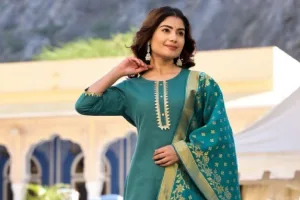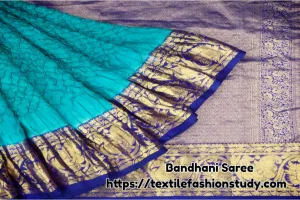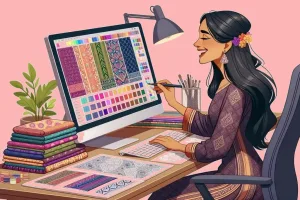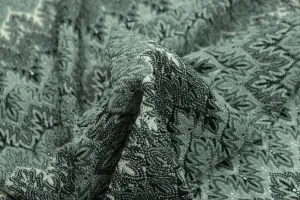Fashion Merchandising
The textile and apparel design sectors both greatly benefit from fashion merchandising. But every company wants to increase its sales and profits, and for a fashion merchandiser, this entails organizing and marketing products to consumers at the appropriate times. The world is fascinated by fashion’s innovative designs and ever-evolving trends since it is such a creative industry. The strong corporate infrastructure that guarantees its smooth functioning, however, is hidden beneath its glitzy exterior.
The discipline of fashion merchandising, which adeptly spans the gap between artistic expression and commercial success, is at the center of this apparatus. This article aims to demystify this interesting profession by exploring the fundamentals of fashion merchandising, looking at the various roles that are played, and then examining the broad range of applications. This article also shows a fashion merchandiser job description.
Table of Contents
Principles of Fashion Merchandising
Core Principles of Fashion Merchandising
Fashion merchandising entails the application of numerous strategies and approaches to control and market fashion products or items. The planning, creation, and presentation of a product line are the fundamentals of fashion merchandising. A collection’s or brand’s uniform look and feel is achieved through the combination of these procedures. The following is the principle of fashion merchandising:
Planning Process
↓
Creating a Fashion Product Line
↓
Presentation of Fashion Product Line
↓
Maintaining Fashion Trends
↓
Boosting Store Sales
Planning Process
To understand current trends and consumer preferences, market research is needed throughout the planning stage of the fashion merchandising process. Merchandisers use this information to create collections that reflect the most recent trends and satisfy customer needs. Planning also takes into account variables like price point, target market, and manufacturing schedule. Finally, a successful collection can be facilitated by a sound plan.

Creating a Fashion Product Line
Creating the product line is the next step in fashion merchandising after a plan has been established. In order to do this, fashion designs must be created together with materials procurement, production planning, and delivery schedules. Mainly, fashion merchandisers collaborate closely with designers, producers, and other members of the production team during the product development process to guarantee a unified and marketable line.
Presentation of Fashion Product Line
Showcasing products to potential buyers and investors is part of the presentation of a product line and is most frequently done during fashion shows or other types of showcases. Choosing how to arrange products for showcases, planning runway events, or creating lookbooks are examples of this. In this stage, it’s essential to promote the brand’s image and create an engaging and appealing display for the products.
Maintaining Fashion Trends
The fashion sector is one where things change quickly. Merchandisers need to stay current with shifts in consumer behavior, societal norms, and fashion trends. Fashion merchandisers can produce items that are both fashion-forward and market-relevant by using trend forecasting tools and researching market indicators.
Boosting Store Sales
Retail sales growth is the main objective of fashion merchandising. In order to increase consumer interest and product visibility, fashion merchandisers collaborate with marketing teams to organize and carry out sales promotions, events, and advertising campaigns. Additionally, they work with retail managers to enhance customer attraction by setting up stores efficiently.
Roles of Fashion Merchandisers
Fashion merchandisers play various roles in the fashion business. However, fashion merchandisers are essential to the lifetime of a product at every level, from concept to consumer. They contribute to deciding which things are offered, how they are presented, and how they are advertised. Their work requires more than just designing visually appealing displays; it also entails smart business choices and thorough planning to guarantee profitability and success. A fashion merchandiser may also be involved in product procurement, pricing tactics, store layout, and data analysis in the fashion sector. Additionally, they could choose outfits and accessories for photo sessions or fashion presentations.

Diverse Roles in Fashion Merchandising
A fashion merchandiser plays different roles in different positions in the industry. The following are the roles of fashion merchandisers in different positions: They are-
Role Of Fashion Buyers
A key position in the world of fashion merchandising is that of the fashion buyer. These specialists are tasked with selecting which clothing items go on store shelves; therefore, they must be aware of current and future fashion trends, conscious of customer preferences, and take the price of each item into account. The choice to add a piece of apparel to a retailer’s inventory is a difficult one that necessitates a careful analysis of sales data. Thus, the fashion buyer’s choices considerably influence consumer interest, driving the store’s sales.
Visual Merchandizers
In the world of fashion merchandising, visual merchandisers are a valuable resource. Their primary responsibility is designing eye-catching, thematic product displays for storefront windows and other areas of the retail establishment, frequently in line with current trends. A visual merchandiser’s main objective is to entice clients into the business, pique their interest, and so enhance the possibility of sales. This is frequently accomplished by developing a vibrant and interesting retail atmosphere. The position calls for a good eye for detail, a solid grasp of current fashion trends, and creativity and innovation skills.
Managers of Merchandising
A vital role in the fashion industry is played by merchandise managers. For a certain product or group of products in a store, they are essential for defining and attaining sales targets. In order to decide which things should be purchased for the store, one of their key responsibilities is to collaborate closely with fashion buyers. It is their intention to strike a balance between the item’s retail worth and the cost of acquisition. They must also guarantee that the products selected support the store’s overarching objectives and plans. To determine whether their choices were successful, they regularly track sales and make necessary corrections.
Retail Managers
Despite not being frequently connected with fashion merchandising, store managers are crucial to the implementation of merchandising techniques. They make sure that the store’s visual presentation is in line with the brand’s image and draws customers in. Store managers are also in charge of supervising the retail personnel, who are crucial to putting the merchandising concepts into action and turning them into sales. Additionally, they keep an eye on in-store sales and client feedback and share this information with the fashion buyers and merchandising managers to inform future choices.
Various Positions
In the field of fashion merchandising, there are numerous additional roles. They include logistics managers, who make sure that goods are efficiently transported from warehouses to retail locations, inventory managers, who ensure that stores have the right amount of inventory, and e-commerce specialists, who oversee online sales of goods.
Each function in the world of retail fashion involves particular responsibilities that add to the overall image. Together, they create a complicated web of responsibilities and tasks required to carry a product from the designer’s sketchbook to the sales floor of a retail establishment. Together, they guarantee efficient operations at a retail site, assist in meeting sales goals, and are essential in getting goods to the final customer.
Scope of Fashion Merchandising
Fashion merchandise has huge scope in the fields of textiles and fashion. They can contribute their excellence to improving the textile and fashion sectors. The overall success of the fashion business is significantly influenced by fashion merchandising. By actively assisting with the commercial viability of designers’ artistic ambitions, it bridges the gap between fashion’s initial invention and its eventual consumer. A wide range of tasks, from product development and sourcing to retail and sales management, are needed in fashion merchandising because of the field’s breadth and depth. With shifting fashion industry trends and consumer habits, this industry is always evolving. The following are the scopes of a fashion merchandiser to show their professionalism: They are-

Fashion Merchandising in the Fashion Industry
Fashion merchandising is a vital pillar of the fashion industry. This position skillfully combines elements of administration, marketing, and visual presentation. Fashion merchandisers are endowed with a keen sense of fashion trends, knowledge of consumer behavior, and a skillful analysis of sales data—all to make sure the right products are highlighted at the perfect time, in the most alluring way. They improve profitability by collaborating with shop managers, retail buyers, and fashion designers to streamline the purchase process.
Contributor to the Fashion Industry
A vital and dynamic aspect of the fashion industry is fashion merchandising. Fashion merchandisers are crucial to the industry’s dynamic and ever-changing landscape, whether they are predicting trends, planning product launches, or overseeing store operations. Their responsibilities and functions are equally varied, providing many opportunities for imaginative and business-minded people interested in influencing the direction of fashion.
Career Opportunities in Fashion Merchandising
There are many different job options available in the world of fashion merchandising. Starting out as a visual merchandiser involves designing appealing product displays to pique customers’ interest. A fashion merchandiser may advance to the position of fashion buyer with time and expertise, who chooses what products to stock the store with depending on anticipated consumer demand and impending trends. The positions of merchandise manager, fashion marketing coordinator, and retail sales manager are also possibilities.
Involvement in Various Sectors and Industries
The duties of fashion merchandising span numerous areas and industries in addition to clothing stores. Fashion merchandisers, for instance, may have opportunities in online enterprises, where they can work to develop enticing online catalogs and enhance the user experience for online buyers. Similar to this, fashion merchandisers may be crucial in deciding price tactics for the luxury goods industry, ensuring that high-end products keep their perceived worth while simultaneously making a profit. Even in event management and public relations organizations, a fashion merchandiser’s abilities and knowledge can be useful because they can aid in the planning and execution of successful fashion events.
Conclusion
The fundamental principles of fabric merchandising—understanding the consumer, developing market-relevant merchandise, and providing a memorable shopping experience—remain true despite the dynamic and ever-changing nature of the fashion sector. The distinct positions within the domain, from fashion buyers and merchandising managers to visual merchandisers, are defined by the conscious articulation of these stages. Together, these positions open up a world of fascinating employment opportunities in the captivating field of fashion. Although the path to mastery may be difficult and tortuous, those who choose it are rewarded with a fulfilling journey that is rich in experiences that have a real impact on the fashion industry.
In sum, a fashion merchandiser has lots of roles and responsibilities; besides this, they have huge scopes in the field of textile and fashion industries.






